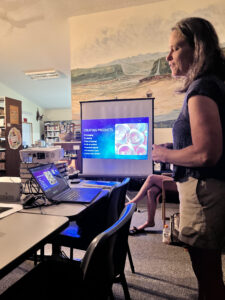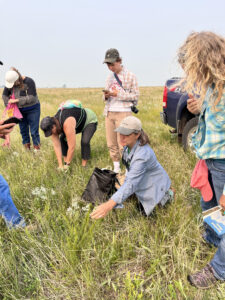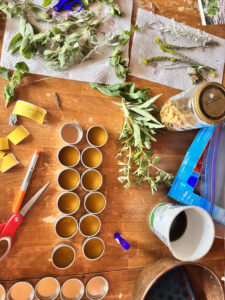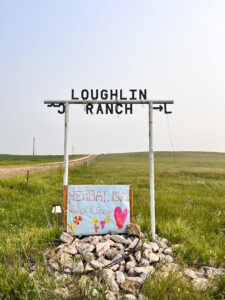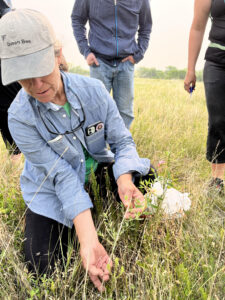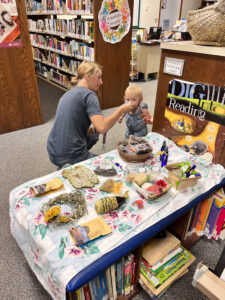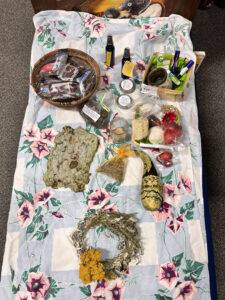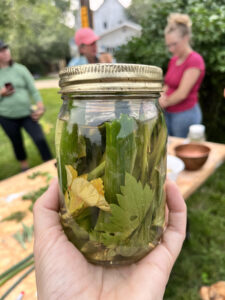Final report for FNC22-1340
Project Information
Our ranch is 1000 acres, plus some leased land. This is a fourth generation ranch. My husband has been the owner/operator since 2008. I have lived here since 2013. We have one small hay field, the rest is grazing land. We keep cattle and sheep, and are working toward rotational grazing year round.
Perkins County is one of the most isolated rural communities in the contiguous United States. The vast majority of our community members are agricultural workers, but almost everything we produce leaves our community to become part of the global supply chain. Meanwhile, it is hard for us to travel for anything other than quick supply runs to other towns.
We want to offer our community access to high quality, in-person events and workshops with craftspeople, artists, and educators in regenerative and sustainable agricultural practices and products. This is a challenge for us since we are so remote. We are just as excited to offer the artisans the opportunity to live and work with us so they can get a glimpse into a community at the origins of the supply chain. An artisan-in-residence program will present our community members with other options and perspectives in innovation and sustainability, specifically in regards to value-added products and the creation of a fibershed, as well as potential for agri-tourism through adding artistic elements to area ranches and farms.
1.) Create an 'artisan-in-residence' program that will include direct instruction and in-person demonstrations on our ranch using locally sourced materials when possible such as fleece and both foraged and locally grown herbs, etc.
2.) Offer a stipend to selected artisans so that demonstrations and classes can be offered on a donation/sliding scale basis
3.) Partner with the Bison Public Library to offer additional access in the form of open classes or "visiting hours" with the artisans.
Cooperators
- (Educator)
- (Educator)
- (Educator)
Research
I did not stray at all from the original proposal for the first residency + workshops. I'm planning to stick to this model for the second offering, so I don't anticipate the process will be different from what I describe in the original proposal. The only thing I will be more mindful of is the weather! I planned alternative options for outdoor activities if it rained, but I did not consider what we would do if it was extremely hot. Which it was! For the 2023 Herbal retreat, we will do it much earlier in the summer to avoid (hopefully) having to do the workshops in 100+ degree heat.
For our first retreat on the ranch, I set the cap at 15 participants. I had planned to use a variety of methods to "get the word out" but I didn't end up needing to use most of them! After posting just once on social media with an Eventbrite link, we were full! Through my personal social media, as well as the Bison Library's channels, plus hanging signs around town, we had great attendance at the demonstration + workshop at the library. I also invited people to stop by the ranch even if they couldn't participate in the full 2 day retreat. To my delight I had a few folks take me up on it.
I did not set a cap for the second retreat, partially because many of the supplies were wildcrafted, and also because Grace was able to bring extra supplies that she said she could take home if they were not used. This made planning much less stressful! I once again invited out-of-town attendees to camp on our land free of charge, and had several take me up on it. However, this retreat attracted more local participants who did not need to stay overnight. I suspected local folks would find herbalism more accessible than the fiber arts, and I was correct. Most of the people who attended were ranchers or farmers (including a few that traveled across the state!), as opposed to the first retreat, which attracted more attendees from urban areas.
This meant the two retreats were quite different in terms of the demographics served, though they were similar in terms of the community that was created during the time we spent together. I would say I reached my goal of providing a shared experience for increased quality of life for our home region with the second retreat, though I am not sure if either retreat will result in local ranchers or farmers attempting their own agri-tourism projects in the future. I had hoped to show with my two offerings that it was accessible for others to host these types of events even if they only had standard infrastructure. In other words, you don't need a fancy facility i.e. resort to attract and serve participants. While I certainly demonstrated that was possible, I don't know that I actually inspired anyone to try it themselves. Time will tell.
The herbalism workshop was also more successful at inspiring conversations about value-added products appropriate for our ecosystem and supply chain. We had a great discussion following Grace's presentation at the library about partnering with local grocery stores and restaurants to get local products in the hands of customers. We also brainstormed ways to use commercial kitchen facilities already available in our area to create products. Several participants left with plans of how they might incorporate these ideas into their operations.
This was another component that I think was successful: By gathering together, we were able to have a cross-pollination of ideas between locals and visitors, and we all left wiser as a result. There were many discussion about growing and wildcrafting for personal use, which I would also count a success for quality of life and sustainability.
One aspect that was not successful in terms of offering a model that other farmers or ranchers could emulate was proving that these kind of events are profitable. I still believe they would be, but I did not prove it! I had hoped by offering these events on a donation basis I could create opportunities that were accessible to all, but that would also generate opportunities for future residencies that were entirely donation based using a 'pay-it-forward' model. That was a failure, as neither event generated enough donations to cover the cost of the event, let alone turn a profit. Though I still think this is a strong model, it means I did not prove, as I had hoped, that these ventures would be profitable for other farmers or ranchers in my region.
Educational & Outreach Activities
Participation Summary:
We held one artisan residency on the ranch in 2022. During her residency, Kelly Knispel, a shepherd, fiber artist and educator, led a workshop + demonstration at our local library. Kelly also offered a two-day workshop and demonstration on our ranch using fiber from our flock and locally sourced natural dyeing materials. Participants took home a drop spindle, a felted project and samples of the yarns we dyed.
In addition to posting before and after the workshops on social media, as well as flyers hung around town, I presented the residency program and workshops to an audience comprised of farmers and ranchers from across the state at the Local Foods Conference in Sturgis, SD this fall. I'm including the slides from my powerpoint at the link below as they also include pictures taken during the various demos & workshops.
Summer of 2023 we held a second residency on the ranch with herbalist, farmer, and registered nurse Grace Freeman as our artisan. Grace first offered a free talk/powerpoint presentation + demonstration at the Bison Public Library about value-added products using wildcrafted and bio-regionally appropriate crops based on her experiences with her company Prairie Moon Herbs and her work with the Vermillion Farmer's Market. Attendees were also treated to samples of wildcrafted herbal tea as well as samples of some of Prairie Moon Herb's products.
Next, Grace held an herbalism retreat at our ranch that was also free and open to the public. The retreat began with a 'plant walk' where we toured one of the pastures with several different diverse micro-ecosystems. Grace helped attendees identify medicinal and edible plants using guidebooks and smart phones, and discussed different uses for these plants as well as "look-alikes." People gathered plants to bring back for use in the afternoon workshops.
After a break, Grace taught several basic preparations for using herbs and other plant products including: drying for tea, herbal vinegars, and salves. Attendees were able to use what they had gathered, as well as herbs from Prairie Moon and my own garden, to create personalized tea blends, vinegars, and salves to take home with them.
The retreat ended with a poetry reading by a visiting poet based on her experiences walking the prairie. Grace (who is also a clogging instructor) taught attendees some basic clogging steps, and I provided live music for an open jam and dancing session!
Learning Outcomes
I will definitely continue to build the artisan-in-residency program! The grant gave me the confidence to continue to follow this vision, and the evidence to prove this is a model that serves both artisans and my greater community. Both retreats were a highlight of my year, especially the second, mostly because I had learned so much from the first I was able to enjoy it more and not worry as much.
While these events were certainly successful at educating about value-added products, I am not sure that they were as successful at actually inspiring folks to try any of these product possibilities themselves. This would be disappointing if the retreats had not been so successful at community building. After both events I had participants express true joy at having the opportunity to learn from such gifted, committed educators and from one another. So, while I don't think I was able to prove much economic benefit from the retreats, I think these opportunities had a value that can't be measured solely financially, and I am very proud of that.
Project Outcomes
I so appreciated this opportunity! In addition to serving my community, the relationships I formed with the artisans Kelly and Grace and the participants in these events are gifts that keep on giving. Thank you!
